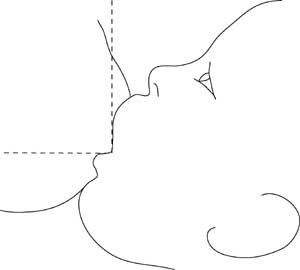 It’s the first thing you learn when your baby is placed in your arms and the labor and delivery nurse encourages you to nurse your baby: the latch. For many moms, the latch seems fine that first time. The nurses and lactation consultants may even tell her, “The latch looks ‘good’.” But, at some point, many moms begin experiencing pain while nursing or have difficulty latching their baby. What changed? Why is the baby suddenly having problems getting a good latch? This is the #1 question new moms have when they call us for help.
It’s the first thing you learn when your baby is placed in your arms and the labor and delivery nurse encourages you to nurse your baby: the latch. For many moms, the latch seems fine that first time. The nurses and lactation consultants may even tell her, “The latch looks ‘good’.” But, at some point, many moms begin experiencing pain while nursing or have difficulty latching their baby. What changed? Why is the baby suddenly having problems getting a good latch? This is the #1 question new moms have when they call us for help.
When we meet with new moms and their babies, the main objective of our visit is to perfect the latch and ensure comfortable positioning. The key to a good latch starts with observing your baby’s hunger cues and initiating breastfeeding at the first signs of hunger. A very hungry baby is going to be FRANTIC and difficult to get into the correct position. So, it’s important to try and catch those first few signs of hunger and offer to nurse BEFORE your baby begins crying. Crying is the last sign of hunger. Look for more subtle cues. Newborns are typically only awake long enough to nurse. So, if your baby has been peacefully sleeping for a while, you can bet he or she will be ready to eat as soon as she/he wakes up. The first clue your baby is getting hungry is witnessing their eyes moving under their eyelids. Rapid eye movement is a sign your baby is entering a lighter stage of sleep and will wake up soon. This is your opportunity to go to the restroom, grab a quick snack, or some water, and gather any nursing essentials (e.g. your burp rag, breastfeeding pillow or foot stool).
The next sign of hunger is waking. As soon as your baby wakes, change their diaper, and get comfortable together in your nursing chair or bed.
Later signs of hunger include: rooting, smacking or licking their lips, or bringing their hands to their mouth. If you haven’t already set-up your nursing space, HURRY! Your baby is ready to nurse.
If you missed the early hunger cues and your baby is crying, it’s important to soothe your baby before bringing him or her to the breast. Trying to latch a crying, frantic baby is difficult, if not impossible.
Now that we have established how to tell when your baby is hungry and when is the best time to initiate nursing, let’s talk positioning.
Cross-cradle: Many new moms find it easiest to nurse in the cross-cradle position. In this position, mom is usually seated up-right with a pillow (or specially designed breastfeeding pillow) securely tucked around her waist. Mom may also like to have a nursing stool (or even a stack of books or a box) under her feet. With her feet elevated, mom can sit back more comfortably and the incline of her knees will help ensure the baby is tucked in, nice and close.
In the cross-cradle position, your baby should be “tummy to tummy;” that is his or her belly should be touching yours, not facing the ceiling. (This is the #1 “mistake” new moms make.) Your arm/hand opposite the breast you are nursing from will be wrapped around your baby, with your thumb and forefinger behind their ears. Supporting your baby’s head/neck in this way will prevent you from accidentally triggering a reflex to snap their head back when a hand is placed on the back of the head.
Your other hand (same side as the breast you’re nursing from) may be used to “sandwich” your breast. If you use your hand to compress your breast – forming a “teat,” just be sure your fingers are placed far back enough that they do not get in the way of your baby latching on to the breast. The fingers should be behind the areola.
The hand that is “sandwiching” your breast can be used to ‘tickle’ your baby’s nose with the nipple or even express a few drops of milk onto your baby’s lips. Wait for your baby to open WIDE. Many babies will open their mouths slightly a few times before really opening WIDE. Be patient and wait for your baby to tilt their head back and open WIDE (like a yawn).
Once your baby opens their mouth nice and WIDE, quickly bring your baby closer in, towards your breast. Try not to force your breast into the baby’s mouth or lean in to your baby. Bring them to you, instead of the other way around.
Now that your baby is latched, first check to see if their lips are flanged out. The lips should not be tucked inward.
Next, look at the angle of your baby’s mouth. The corners of the mouth should not be tight. If the corners of your baby’s mouth resemble a greater than sign: >, they most likely do not have a good latch. The angle of your baby’s mouth should be greater than 140 degrees and resemble a parenthesis: ).
Bad Latch
Good latch
Signs of a good latch include:
- Baby’s cheeks are rounded
- Baby’s lips are flanged out
- Chin and nose are very close to the breast
- Nursing is not painful
- The nipple comes out unchanged (not mishapen, pinched, white, or angled like a tube of lipstick)
Need in-person help with getting a good latch? We offer in-home lactation consultations 7 days/week! Schedule an appointment, call (407) 595-5054 to speak with our Certified Lactation Counselor or email us at info@lactationconsultantsofcentralfl.com.



